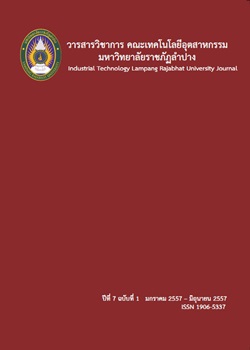กระเบื้องเซรามิกมวลเบาชนิดใหม่ทำจากหางแร่ดินขาว และเถ้าลอยไม้ยางพารา
Keywords:
กระเบื้องเซรามิกมวลเบา, หางแร่ดินขาว, เถ้าลอยไม้ยางพารา, เทคโนโลยีสีเขียว, lightweight ceramic tile, kaolin refining waste, Para rubber wood fly ash, green technologyAbstract
การศึกษาครั้งนี้ประเมินความเหมาะสมของหางแร่ดินขาวว่าเป็นแหล่งทางเลือกของวัสดุดิบ เซรามิกสำหรับการผลิตเนื้อกระเบื้องเซรามิก การเติมเถ้าลอยไม้ยางพาราที่มีต่อสมบัติทางกายภาพ และเชิงกลของกระเบื้อง หลังจากนั้นเผาที่สามอุณหภูมิเริ่มที่ 1050 1100 และ 1150 องศาเซลเซียส บรรยากาศออกซิไดส์ ตรวจสอบคุณลักษณะของกระเบื้องตัวอย่างที่เผาผนึก ได้แก่ ความได้ฉาก ความหนาแน่นรวม น้ำหนักสูญหาย การหดตัวหลังเผา การดูดซึมน้ำ ความแข็งแบบชอร์ กำลังดัด และความคงทนต่อสารเคมี ส่วนผสมที่เหมาะสมพบว่าอัตราส่วนเถ้าลอยไม้ยางพาราร้อยละ 10 เผาที่อุณหภูมิ 1150 องศาเซลเซียส มีการดูดซึมน้ำและกำลังดัดอยู่ในช่วงร้อยละ 7.95 – 12.50 และ 4.87-10.96 เมกะพาสคัล ตามลำดับ พบแร่วัฏภาคมุลไลต์และอะนอร์ไทต์ขัดประสานกันมีรูพรุนทรง เรียวยาวทั่วไป ปริมาณเถ้าลอยไม้ยางพารามีผลกระทบอย่างมากต่อกำลังและการเปลี่ยนรูปในช่วงได้ ความร้อน กระเบื้องเซรามิกมวลเบาสามารถผลิตได้จากเทคโนโลยีสีเขียว
Novel Lightweight Ceramic Tile Made from Kaolin Refining Waste and Para Rubber Wood Fly Ash
The present study evaluated the suitability of kaolin refining waste as an alternativesource of ceramic raw material for the production of ceramictile bodies with Para rubber wood fly ash (PRWFA) addition. Several formulations were prepared and sintered at different temperatures of 1050 1100 and 1150◦C in an oxidation atmosphere. The sintered samples were characterized to determine their porosity, water absorption, firing shrinkage, weight loss, Shore hardness, flexural strength and chemical resistance. The microstructure and the phase composition of the fired samples were analyzed by scanning electron microscopy (SEM) and X-ray diffraction (XRD). The resultsindicated that ceramic tile formulations containing up to 10% of PRWFA and firing temperature of 1,150◦C could be used for the production of tiles with water absorption in the range of 7.95–12.50% and flexural strength of the fired specimen were and 4.87-10.96 MPa, respectively. The mullite and anorthite phases were found by XRD of the sintered specimen and SEM microphotographs revealed crystals interlocking with elliptical pores. Effect of PRWFA contents was highly on loss strength and pyroplastic deformation of the tiles. Lightweight ceramic tile can be manufactured from green technology.






